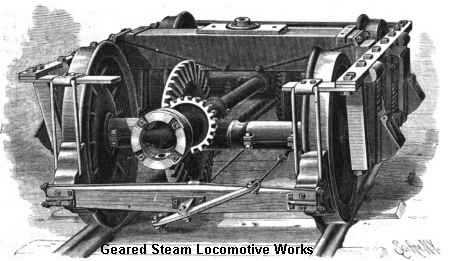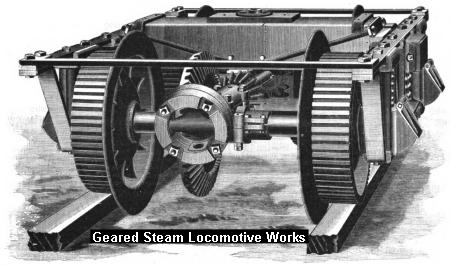The geared locomotive is finding increasing favor for work on the
heavy grades encountered in mountain logging. The device of coupling on
another pair of axles when it is desired to increase the adhesion, which
is practicable on trunk railroads, is impossible on the average logging
road, on account of the sharp curvature of the line. The length of the
rigid wheel base must be kept down to a point which prevents any
successful coupling up of many drivers by the ordinary methods.
*****
DO NOT COPY **** Violators will be prosecuted! gearedsteam.com

Driving Gear Of Truck For Logging Locomotive.
The 25 ton locomotive shown in the accompanying illustrations is
one of a type that is manufactured by the Climax Manufacturing Company,
of Corry, Pa, for use in logging camps, coal mines, sugar plantations
and under any conditions where heavy grades and rough and uneven track
are encountered. The necessary lateral flexibility is obtained by
carrying the locomotive upon two end trucks and transmitting the power
to the wheels, all of which act as drivers, by means of flexible
shafting and bevel gears.
***** DO NOT COPY ****
Violators will be prosecuted! gearedsteam.com
The frame consists of two 8 inch channel irons, and has large
corner brackets riveted to the channels and bolted to oak end sills. The
channels are also connected by double trussed iron bolsters which
distribute the weight to the trucks.

Truck of Logging Locomotive For Use On Wood Rails.
The cylinders are bolted to the frame and the power is
transmitted from the engine shaft by means of heavy steel bevel gears to
a flexible shaft, which runs beneath the frame and over the center of
the trucks. The details of the driving mechanism on the trucks are shown
in the accompanying illustrations, one of which shows the style with
corrugated wheels adapted for use on wooden track and the other for use
on ordinary steel rail. At is junction with the trucks the line shaft is
provided with a universal joint, and it is carried in cross boxes
journaled upon the axles, the alignment being secured by means of sleeve
couplings and bronze rings, which hold the gears in mesh and the line
shaft in position. The cross boxes are provided with metal liners 14
inches long, adjustable to wear. The two inside pinions, which are cast
solid to the horns, are keyed to the line shaft, and thus each wheel of
the locomotive is made practically a direct driver. The axles are 4
inches and the line shafts 3 inches in diameter. There are ten coil
springs in each truck, one over each axle and the others between the
sandboards. A steam brake cylinder is attached to the center of each
truck, by which means the use of long brake rods, which cause corner
binding on curves is avoided.
The latest system of carrying the cross boxes and arranging the
gear is that shown in the truck for use on steel rails, where the
pinions are arranged on the outside of the axles.
*****
DO NOT COPY **** Violators will be prosecuted! gearedsteam.com
These locomotives are doing good work on logging roads having
grades up to 8 feet in 100. In one case a 25 ton engine has pulled four
loaded standard gage logging cars, with 3,000 to 5,000 feet of green
hemlock logs on each car, up an 8 per cent grade and twelve loaded cars
over a 4 per cent grade.
***** DO NOT COPY **** Violators will be prosecuted! gearedsteam.com

A Twenty-Five Ton Geared
Logging Locomotive
________________________________________________